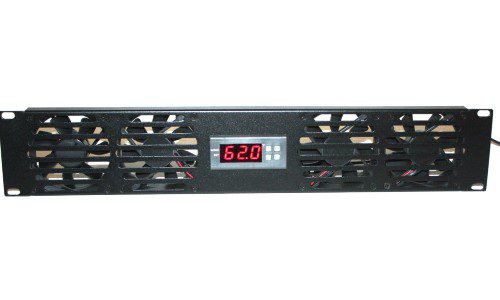You’ve designed and spec’d a killer AV system and it’s time to prep that stack of equipment into its proper rack placement. You’ve outfitted equipment racks full of gear countless times, so no problem, right? Every AV system installation has the potential for problems down the road, so let’s try to prevent any that may arise due to overheating rack systems – here are three myths about AV rack cooling to consider on your next job.
Myth 1: Today’s equipment doesn’t generate enough heat to warrant AV rack cooling.
Is this really the case? Digital amplifiers may be more efficient than traditional class AB amplifiers (we won’t talk about class A or tube-type systems!) at full power output, but unless your clients are listening to sine waves at full power, digital/switch-mode amps still consume more power at low to moderate listening levels than is delivered to the speakers.
That difference shows up as heat.
It’s true that if you only consider the output stages, switch-mode amps are efficient at lower power levels, but when the power required for circuitry “overhead” – i.e. low-level stages, analog-to-digital conversion, power supply regulators, etc. – are included, efficiency drops.
Also, while some gear has is no longer widely used (remember DVD players?), home networking equipment is being added as AV systems start looking more like IT installations.
Myth 2: Just use racks that come with fans installed – problem solved!
Not quite. Almost all preinstalled rack fans lack automatic thermal controls to turn them on only when needed and are rarely quiet; most are AC powered. AC fans move a lot of air but generate high levels of motor noise and air “whoosh” sounds.
These fans are always installed in the top cover of the rack; top-mounted fans tend to draw most fresh air in near the top of the rack, even when side and back panels are installed; there’s little air flow near the bottom.
If most heat is generated near the bottom of the rack (where large amplifiers might be located for seismic considerations), they typically get little cooling from top-mounted fans.
So…we have loud fans that must be turned on and off manually – not a happy or efficient situation.
The better approach is to put cooling systems into the rack where needed. Just above a major heat-generator with a vent panel below, perhaps? That can be an effective solution unless there’s a closed door in front of the rack.
If there is, rear-mounted fans can be used, but only if there’s no rear door to block airflow. If there are front and rear doors, heat generators may have to be relocated to the top of the rack and top-mounted fans installed.
Myth 3: We’ve cooled the rack – we’re done.
Again, not so fast. If the rack is free-standing, you may be finished, but in many installations it’s tucked into a cabinet or closet. It’s not enough to move the heat out of the rack and into the cabinet; you also have to move it out of the cabinet or the same hot air will just circulate while increasing in temperature.
There are cooling systems available to mount in cabinet sides or closet walls to exhaust heated air into an adjacent hallway or utility room, and fresh air can be brought in (passively) through a 3/8 – ½-inch gap under the door or a grille set into the door.
Also, if the rack has several open positions allowing air to circulate through it, a properly sized closet/cabinet cooling system can make it unnecessary to install fans in the rack itself.
Author Frank Federman is CEO of equipment cooling specialist Active Thermal Management.







